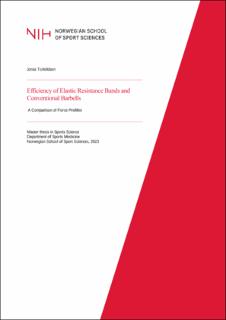| dc.description.abstract | Exercising with elastic resistance bands (ERB) has gained popularity over the past 5-10 years, but there is little research on how muscles are utilized during ERB exercises compared to conventional weights. To provide a better understanding on how ERB training can be optimized, the purpose of this study was to measure and compare force output profiles between ERB standing press and -pull and barbell-based bench press and -pull. By employing a cross-sectional, within-subjects study design, we collected data from 19 healthymen (N=14) and women (N=5). Force profiles were generated in a purpose-built Smithmachine during bench press - and pull, with isokinetic resistance (measuring maximumforce output capabilities) and conventional weight plates (measuring 6 repetition maximum). 3D motion capture in combination with a load cell were used to measure 6RM standing press and -pull forces using ERBs. Data were processed and analysed usingMatlab with the SPM1d package (Statistical Parametric Mapping 1d). Our results indicate that press exercises with ERBs has a comparable force profile, but lower force output throughout the exercise trajectory compared to the maximumforce output capability for isokinetic bench press up to 80% of total exercise trajectory length. Conventional bench press does not follow the isokinetic force profile, and the force output is virtually constant through a large section of the exercise trajectory. For pull exercises, ERB force profiles match poorly the isokinetic force profile, because the ERB load increases, while the maximum force output capability drops from 30% up the end of the exercise. According to our data, the shape of the conventional bench pull profile correspond well with the isokinetic force output. No significant statistical differences were found between ERBs stretched to 100% and 200% for neither standing press nor -pull. We conclude that ERBs are a convenient, user-friendly and viable alternative to conventional press exercises, but less efficient as replacements for conventional pull exercises. ERB training may be optimized to better match themaximumforce output capability profiles during press and pull exercises. | en_US |
